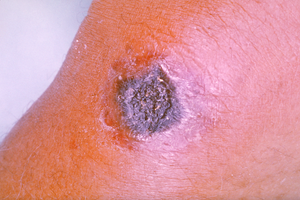Anthrax
| Anthrax | |
|---|---|
 |
|
| A skin lesion caused by anthrax | |
| Classification and external resources | |
| Specialty | Infectious disease |
| ICD-10 | A22 |
| ICD-9-CM | 022 |
| DiseasesDB | 1203 |
| MedlinePlus | 001325 |
| eMedicine | med/148 |
| Patient UK | Anthrax |
| MeSH | D000881 |
Anthrax is an infection caused by the bacterium Bacillus anthracis. It can occur in four forms: skin, inhalation, intestinal, and injection. Symptoms begin between one day and two months after the infection is contracted. The skin form presents with a small blister with surrounding swelling that often turns into a painless ulcer with a black center. The inhalation form presents with fever, chest pain, and shortness of breath. The intestinal form presents with nausea, vomiting, diarrhea, or abdominal pain. The injection form presents with fever and an abscess at the site of drug injection.
Anthrax is spread by contact with the spores of the bacteria, which are often from infectious animal products. Contact is by breathing, eating, or through an area of broken skin. It does not typically spread directly between people. Risk factors include people who work with animals or animal products, travelers, postal workers, and military personnel. Diagnosis can be confirmed based on finding antibodies or the toxin in the blood or by culture of a sample from the infected site.
Anthrax vaccination is recommended for people who are at high risk. Immunizing animals against anthrax is recommended in areas where previous infections have occurred. Two months of antibiotics, such as doxycycline or ciprofloxacin, after exposure can also prevent infection. If infection occurs treatment is with antibiotics and possibly antitoxin. The type and number of antibiotics used depends on the type of infection. Antitoxin is recommended for those with widespread infection.
Anthrax among humans is most common in Africa and central and Southern Asia. It also occurs fairly regularly in Southern Europe, but is uncommon in Northern Europe and North America. Globally, at least 2,000 cases occur a year, with about two cases a year in the United States. Skin infections represent more than 95% of cases. Without treatment the risk of death from skin anthrax is 24%. For intestinal infection the risk of death is 25% to 75% while in inhaled anthrax despite treatment it is around 50% to 80%. Until the 20th century, anthrax infections killed hundreds of thousands of people and animals each year. Anthrax has been developed as a weapon by a number of countries. In plant-eating animals, infection occurs when they eat or breathe in the spores while grazing. Carnivores may become infected by eating infected animals.
...
Wikipedia
